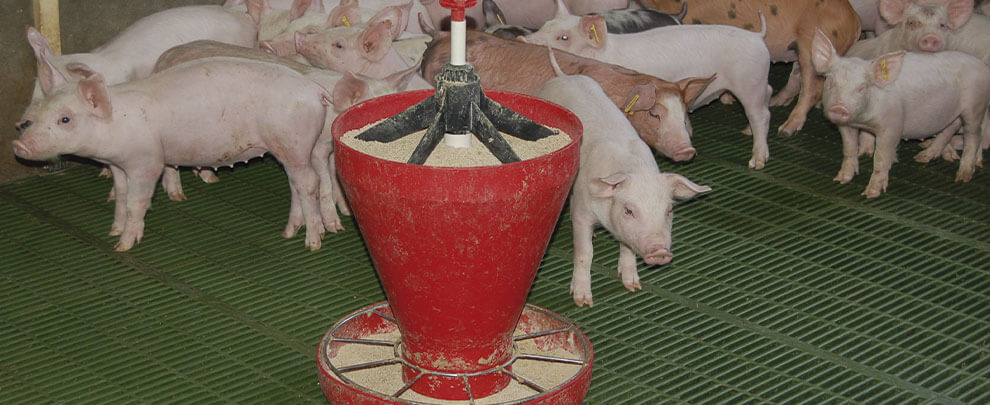Blog
Blog

Strategies to reduce the environmental impact of slurry though feeding
19th May 2020 - Studies
The growth of pig production has brought a significant increment in the production of slurry, with the consequent environmental impact if it is not treated properly. This is even more important in areas with a high density of livestock. As the first step of any treatment is reduction on emission, Núria Llanes, animal nutritionist at the Cooperativa d'Ivars d'Urgell, explains how pig feeding influences their excretions and what measures to apply in their diet to reduce the amounts of nitrogen and phosphorus in the manure.
INTRODUCTION
The components of the slurry with the greatest environmental impact are nitrogen, which can cause nitrification of aquifers and acid rain, and phosphorus, which can cause eutrophication problems. To reduce the impact of these components when used as a fertilizer, current legislation foresees a maximum limit of nitrogen application (N) of 210 kg / ha and year, a figure that is reduced to 170 kg / ha and year in areas vulnerable to the contamination of the underground water by nitrites. But, what the sector can do to reduce the levels of nitrogen and phosphorus in the manure?
MEASURES IN FEED
The relationship between pig feeding and slurry production is direct, "so, by modifying their diet, we can modify the composition of the droppings," Núria says.
Based on this premise, the animal nutritionist lists different feeding measures to reduce the amounts of nitrogen and phosphorus in the slurry, and ensures that “through feed we can achieve a reduction of 40-50% in nitrogen, and 25% in phosphorus ”.
1. Reduce excess of protein
Avoiding an excess in the protein intake in the animals' diet is the most effective feeding measure to reduce the amount of nitrogen in the feces. "It is very important that what the animals eat is adjusted to their needs, that there is no more protein than necessary so that nitrogen is neither over nor missing," Núria says.
To compensate the protein reduction, feed is supplemented with amino acids and additives. In the first case, amino acids lower the levels of crude protein and facilitate the digestibility of feed, which helps to reduce the nitrogen content of the feces. In the second case, phytases are the most widely used additive to improve phosphorus digestibility.
2. Multiphase feeding
The application of a multiphase diet (the use of different feeds that adapt to the nutritional needs of animals throughout their lives) minimizes an excessive supply of amino acids and reduces the nitrogen in the excrement. "Multiphase feeding allows us to adjust to the nutritional requirements of animals at all times," explains Núria, who adds: "If I can only set a nutritional level from when animals enter until they leave, I will not be able to adjust to their needs; on the other hand, if I can have three levels, I will be able to adjust better to what they need in each phase ”.
Multiphase feeding implies, on the one hand, a reduction of nitrogen in the slurry and an economic saving as well. "Protein is the second most expensive nutrient in the feed formula, so when adjusting to the protein needs of animals at all times, the cost of feed is less," says the nutritionist.
3. Improve productive efficiency
Finally, based on the fact that one of the factors that most influences the production of slurry is how animals transform the kilos of feed they eat into meat, since what they eat and do not transform is wasted and becomes slurry. Therefore, it is very important that the quality of the feed is higher and higher so that the pigs digest and transform their nutrients much better.
In order to obtain and improve productive efficiency through feed quality, it is very important not to forget to be demanding in farm management: to reduce feed waste, control water consumption and ensure its quality, improve environmental conditions, etc. . "If we improve production efficiency, animals will consume less kilos of nitrogen to create 1kg of meat and, therefore, they will excrete less," he concludes.
FACTORS THAT INFLUENCE THE DIET
Before deciding what changes to apply in the feeding of our animals, Núria points out that different factors that influence the consumption of animals must be taken into account:
- Genetics influences the amount of feed that is consumed, and the levels of protein required, so it is necessary to know these peculiarities.
- Gerder, and if we work with castrated animals, it is also a factor to consider. "The castrated males are those that eat the greatest amount of feed, then there are the females, and finally, the non-castrated males," says Núria.
- The feeder model (dry - wet) is also relevant. If we work with wet feeders, the consumption of the animals is higher than with the dry feeder, so if there is not good management on the farm, the droppings volume may be higher.
- Insulation of the facilities. If the insulation of the buildings is not adequate, there are more excrements. “Poor insulation causes animals to eat more in winter and therefore excrete more, and in summer they eat less and grow more slowly, so pigs spend more time on the farm and the number of feces increases”, explains Núria.
CONCLUSIONS
Feeding is a key tool to reduce the environmental impact of livestock manure and reduce production cost. In this context, Núria explains that "the challenge for feed manufacturers is to continue adjusting the protein without affecting the productivity of the animals." On the other hand, among the future challenges of the sector is the improvement of feed as one more alternative in reducing the use of antibiotics. "Diet influences the stability of the intestinal flora and, therefore, that there are fewer digestive problems. However, feed cannot have such a direct impact on other diseases, such as respiratory diseases, "says the nutritionist.






